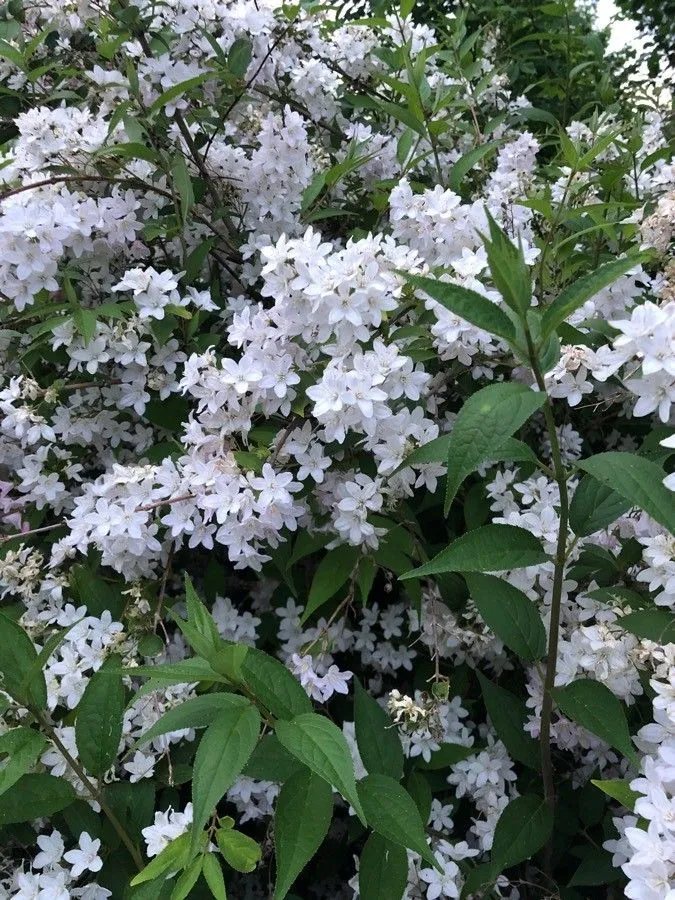
Author: Siebold & Zucc.
Bibliography: Fl. Jap. 1: 22 (1835)
Year: 1835
Status: accepted
Rank: species
Genus: Deutzia
Vegetable: False
Observations: C. & S. Japan
The Japanese snowflower, scientifically known as Deutzia gracilis, is a delicate and captivating plant that belongs to the Hydrangeaceae family. This elegant shrub is a testament to the beauty of simplicity, with its graceful form and profusion of pristine white blossoms.
Native to central and southern Japan, Deutzia gracilis thrives in a variety of conditions, showcasing its adaptability. It was first thoroughly documented in the mid-19th century, specifically in 1835, by the renowned botanists Siebold and Zuccarini. Their meticulous work on this species is recorded in the botanical literature “Flora Japonica,” where it is referenced as part of their first volume.
The Japanese snowflower is particularly noted for its ornamental value. The plant typically grows to a height of 2 to 4 feet, making it an ideal choice for garden borders and decorative plantings. Its slender, arching branches are densely covered with lanceolate leaves, creating a lush green backdrop that enhances the visual impact of its blooming period.
In late spring to early summer, Deutzia gracilis transforms as clusters of small, star-shaped flowers burst into bloom. These blossoms, arranged in elegant panicles, are a brilliant white, occasionally tinged with hints of pink. Their subtle fragrance further adds to the allure of this plant, making it a favorite among gardeners and landscapers.
Cultivating Japanese snowflower is relatively straightforward, as it is a hardy plant that can tolerate a range of soil types. It prefers well-drained soil and thrives in full sun to partial shade. Regular pruning after the flowering season helps maintain its shape and encourages more prolific blooms in the following year.
Deutzia gracilis’s resistance to pests and diseases, along with its minimal maintenance requirements, makes it a practical choice for both novice and experienced gardeners. Its versatility and charming appearance are why it continues to be a beloved plant in horticultural circles around the world.
Whether planted en masse for a striking visual statement or as a singular focal point, the Japanese snowflower embodies a serene aesthetic that captures the essence of natural elegance. Its historic roots and enduring appeal make it a timeless addition to any garden.
Eng: japanese snowflower, slender pride of rochester, slender deutsia
Dan: lille stjernetop
Deu: zierliche deutzie
Swe: bruddeutzia
Por: coco-alado
Nld: witte deutzia
En: Japanese snowflower, Slender deutsia, Slender pride of Rochester, Slender Deutzia
Da: Lille stjernetop
Nl: Witte deutzia
De: Zierliche Deutzie
Pt: Coco-alado
Sv: Bruddeutzia
: Slender pride of rochester
Taken May 18, 2020 by Alexandra Marchetti (cc-by-sa)
Taken Oct 30, 2022 by janev10 Jan (cc-by-sa)
Taken May 17, 2015 by Tela Botanica − Marie-Laure Dumont (cc-by-sa)
Taken Apr 19, 2021 by koji tanaka (cc-by-sa)
Taken May 19, 2014 by Tela Botanica − Remi Combaz (cc-by-sa)
Taken Jun 3, 2022 by Sabine Kramer (cc-by-sa)
Taken Apr 30, 2019 by Ludmilla RUAUD (cc-by-sa)
Taken Apr 8, 2022 by Sabi Shaw (cc-by-sa)
Taken May 13, 2022 by Kai Best (cc-by-sa)
Taken Oct 9, 2020 by kunal singh (cc-by-sa)
Taken May 8, 2022 by Dieter Albrecht (cc-by-sa)
Taken May 27, 2020 by david david (cc-by-sa)
Taken Apr 30, 2019 by Ludmilla RUAUD (cc-by-sa)
Taken May 2, 2022 by Fabrice Rubio (cc-by-sa)
Taken May 9, 2020 by Christian Alandete (cc-by-sa)
Taken Jul 8, 2017 by kristina jaques (cc-by-sa)
Taken May 10, 2021 by Sabin Poenariu (cc-by-sa)
Taken Dec 1, 2021 by Marco Di (cc-by-sa)
Taken May 10, 2021 by Ionela Poenariu (cc-by-sa)
Taken May 19, 2014 by Tela Botanica − Remi Combaz (cc-by-sa)
Taken May 17, 2022 by 道草 (cc-by-sa)
Taken Jul 22, 2021 by Lucie Detaeye Cizkova (cc-by-sa)
Taken Jul 22, 2020 by Montague Ramblefield (cc-by-sa)
Taken Apr 19, 2021 by Ona L (cc-by-sa)
Taken Apr 26, 2020 by nbx (cc-by-sa)
Taken Apr 19, 2021 by Ona L (cc-by-sa)
Taken Apr 19, 2021 by Ona L (cc-by-sa)
Taken Jun 27, 2019 by Ryan Wheal (cc-by-sa)
Growth form>: Multiple Stem
Growth habit>: Shrub
Growth rate>: Moderate
Ph maximum: 7.0
Ph minimum: 5.0
Family: Myrtaceae Author: (F.Muell.) K.D.Hill & L.A.S.Johnson Bibliography: Telopea 6: 402 (1995) Year: 1995 Status:…
Family: Rubiaceae Author: Pierre ex A.Froehner Bibliography: Notizbl. Bot. Gart. Berlin-Dahlem 1: 237 (1897) Year:…
Family: Sapindaceae Author: Koidz. Bibliography: J. Coll. Sci. Imp. Univ. Tokyo 32(1): 38 (1911) Year:…
Family: Asteraceae Author: A.Gray Bibliography: Pacif. Railr. Rep.: 107 (1857) Year: 1857 Status: accepted Rank:…
Family: Fabaceae Author: Medik. Bibliography: Vorles. Churpfälz. Phys.-Ökon. Ges. 2: 398 (1787) Year: 1787 Status:…
Family: Aspleniaceae Author: (Cav.) Alston Bibliography: Bull. Misc. Inform. Kew 1932: 309 (1932) Year: 1932…